Indoor Sport Services Training Guide
Our Indoor Rowing Training Guide is the ultimate training resource for the Indoor Rower. Written by top education and coaching specialists, it includes information on technique and training, with programmes on cross-training, 2,000m and marathon race training, weight management and keep fit. There are guest chapters written by top names such as Jurgen Grobler and Chris Shambrook as well as dedicated sections on psychology, nutrition and weight training.
Appendix - The Performance Monitor - PM3 & PM4
<< The Performance Monitor - PM2+PM3 Menu Structure >>Introduction
The Performance Monitor is designed to be menu driven and self-explanatory. We encourage you to spend a little time pushing buttons and following the menus. If you press the wrong button, just use the "MENU BACK" button to return to the previous menu. For additional information select "Information" from the main menu. The following section gives information about the PM3, the basic operation of the PM4 is the same although it has some additional features. PM3 and PM4 menus structures follow this section.
Getting Started
- The PM3 turns on when you press the ?MENU BACK? button, take a stroke, or insert a LogCard.
- The PM3 turns off automatically after four minutes of inactivity.
- The first time you turn on the PM3, you will be prompted to set the language, date and time. IMPORTANT: Setting the date will allow your results to be stored correctly.
Operation

Lets you select one of four units for your results: meters (or time), time/500m, watts, and calories. This button is active in rowing displays, result screens, and when setting PaceBoat.

Lets you select one of five rowing displays: All Data > Force Curve > PaceBoat > Bar Chart > Large Print. This button is only active from the rowing displays.

Returns you to the previous menu. From rowing displays, ?MENU/BACK? ends the workout and returns you to the main menu.

Battery compartment under back panel with single screw
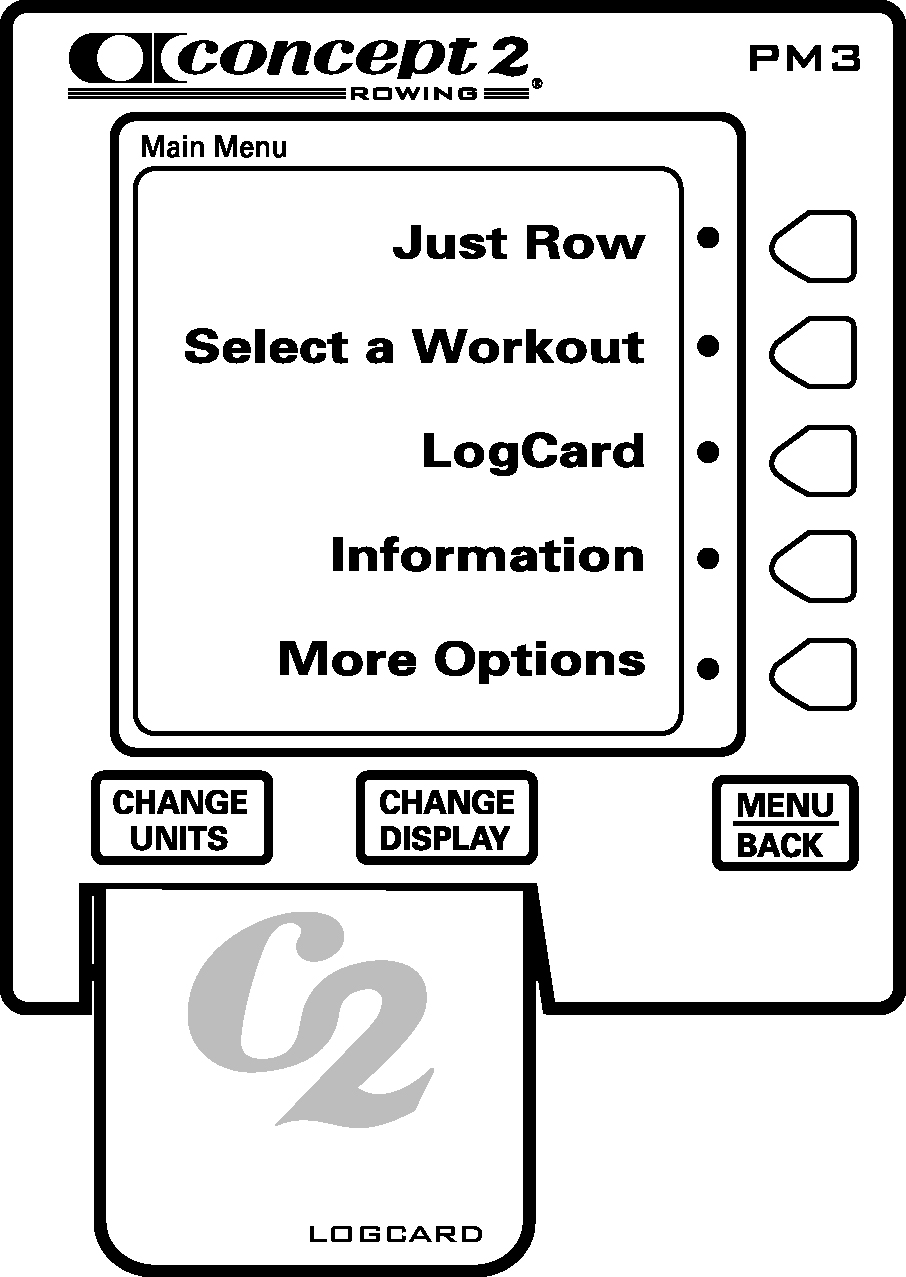

Use these five button to make your selections from the menus. From rowing displays, use these as an alternative way to change display

With a LogCard, the PM3 becomes your personal training tool. Insert your LogCard here before setting up a workout and your results will be saved on the LogCard. After your workout, return to the main menu before removing your LogCard to ensure complete data storage. Contact Concept2 for additional LogCards.
Workouts
Pre-Set Workouts
There are three kinds of pre-set workouts in the PM3: Standard List, Custom List and ReRow. If you have a LogCard, you can also access Favorite Workouts.
- From Main Menu: [Select Workout] > [Standard List] > Select from the standard list of workouts that includes: 2,000m, 5,000m, 10,000m, 30 minutes and an interval workout of 500m/1:00. When you select a workout, it will automatically be set up on the rowing screen. The workout begins when you start to row.
- From Main Menu: [Select Workout] > [Custom List] > Select from workouts that have previously been set up and stored. The PM3 comes with a list of custom workouts, but if you have a LogCard you can replace them with your own. With your LogCard inserted select [Set Workout] > [New Workout]. When you have finished setting up the workout you will be asked if you wish to save the set-up to your Favorites. Later, you can use [More Options] > [Edit Custom List] > to copy one or more workouts from the LogCard to the PM3 memory.
- From Main Menu: [Select Workouts] > [ReRow] > then select the type of workout you wish to ReRow. You will then be able to view a list of previous workouts. Select the workout you wish to ReRow. That workout will automatically be set up on the rowing screen and your previous performance will be used to drive the PaceBoat.
- Favorites: [Select Workout] > [Favorites]
Programming Workouts
The PM3 allows you to program your own specific workouts.
From Main Menu: [Select Workout] > [New Workout] > then select the type of workout: Single Distance, Single Time, Intervals: Distance, Intervals: Time, Intervals: Variable. Enter the information needed to set up the desired workout. When you have finished with the set-up, select ?Done?. The PM3 will then be ready to start the workout as soon as you start to row.
Intervals: Variable allows you to set a different distance or time for each interval, up to a total of 30 intervals.
Splits
Single piece workouts are split into segments called ?splits? for storage and analysis.
More splits require more storage space on the LogCard. The PM3 will default to five segments or splits per piece. You can change this to a desired split time or distance. Note that a maximum of 30 splits is allowed per workout, and minimum split size is 20 seconds or 100 metres. There are no splits for interval workouts. Note that if you choose to store more splits per workout, your LogCard will store fewer workouts.
NOTE: For any interval workout the first interval starts when you begin to row. All other intervals start as soon as the rest period is finished.
LogCard

The LogCard allows you to:
- Store hundreds of detailed workout results.
- Edit your lifetime metres to include workouts not stored on the LogCard.
- Save your favorite workout settings.
- Race against a previous workout.
- Remember your preferred language, display and units.
- Add up to five users per card.
Your LogCard will automatically be formatted the first time you insert it in the PM3. You will then be instructed to: Add New User - Set your user name using up to six letters.
If you would like to carry forward your previous lifetime metres to this LogCard, use [Main Menu] > [LogCard] > [LogCard Utilities] > [Edit LogCard].
Each LogCard can serve up to five users, but heavy users will probably want to have their own card. The LogCard will hold hundreds of workout results and you will be warned when it is filled.
To add additional users to your card:
[Main Menu] > [LogCard] > [LogCard Utilities] > [Add User]
To delete a user from your card:
[Main Menu] > [LogCard] > [LogCard Utilities] > [Delete User]
To make a correction to your LogCard or User name:
[Main Menu] > [LogCard] > [LogCard Utilities] > [Edit LogCard]
To delete a workout from the LogCard:
[Main Menu] > [LogCard] > [LogCard Utilities] > [Delete Workout]
To copy a workout from LogCard to PM3 Custom Workouts:
[Main Menu] > [LogCard] > [LogCard Utilities] > [Copy Workout]
Your total workout results and the split or interval data are stored automatically in the PM3 Memory and on the LogCard. Also displayed are the average stroke rates and the ending heart rates (if the heart rate option is used). When the PM3 memory is full, the oldest result will be deleted. The LogCard will hold hundreds of workout results and you will be warned when it is full.
If no LogCard is installed
From Main Menu: select [Memory] to view a chronological list of the last workouts that fit into the memory. Use the cursor buttons to select the workout you wish to view. The memory stores data for each split or interval of your workout.
If a LogCard is installed
From Main Menu select [LogCard]. Or, from the LogCard User screen, select: [LogCard Menu].
You will then select how you wish to view your log information.
- A one page summary of your log.
- A history of your monthly totals.
- A list of your workouts by date. Use the cursor buttons to select the workout you wish to view in detail. The LogCard stores data for each split or interval of your workout.
- A list of your workouts by workout type. Use the cursor buttons to select the workout you wish to view in detail.
As with all electronic storage media, we encourage you to make frequent backups of your LogCard data, either by transferring it to a PC or keeping written documentation of key data such as Lifetime Total Metres.
Drag Factor

"Drag Factor"
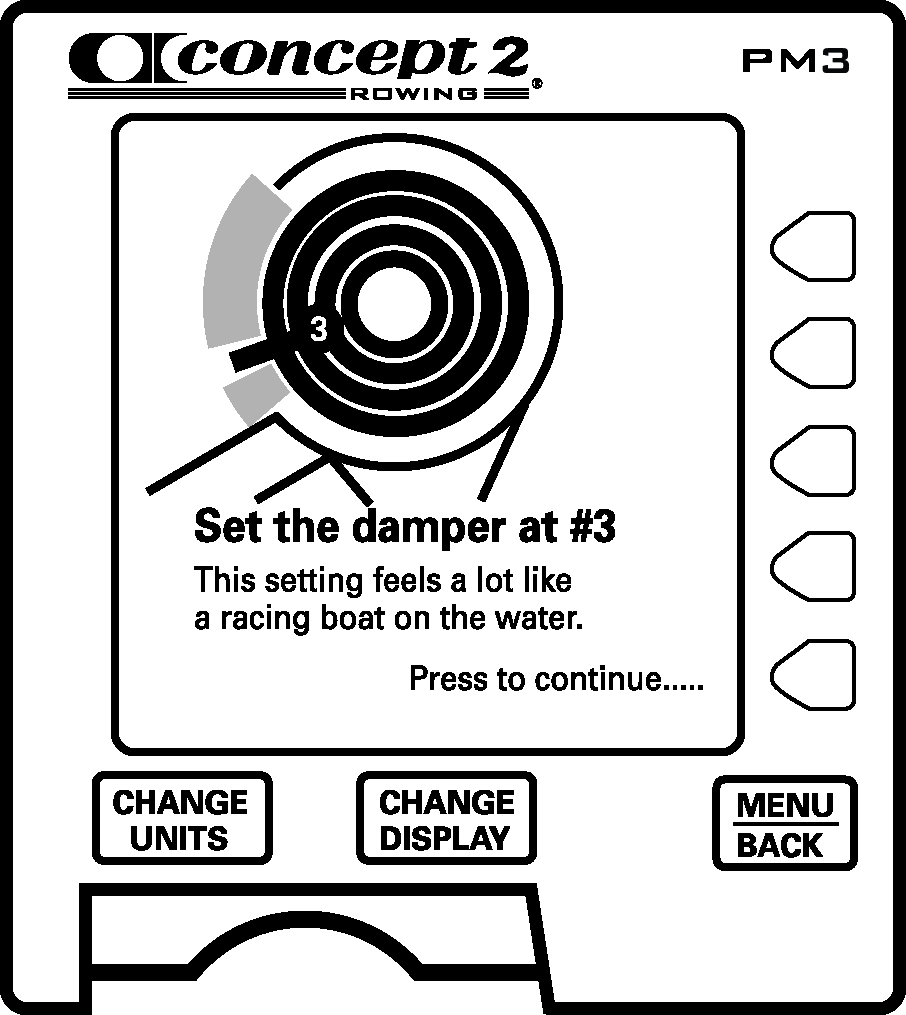
Adjust the Drag Factor by moving the damper lever on the side of the flywheel. This will alter the feel of the stroke. High numbers feel slow and heavy, lower numbers are more like a racing boat. It is best to use a Drag Factor between 100 and 140. This is usually a damper number between 2 and 5. The Drag Factor can be viewed from the More Options menu. Use a Drag Factor that feels most comfortable to you and gives you the best result for the workout.
The damper lever setting required to achieve a certain Drag Factor will vary from one machine to another due to elevation, manufacturing tolerances and accumulated dust inside the flywheel cover.
Display Options
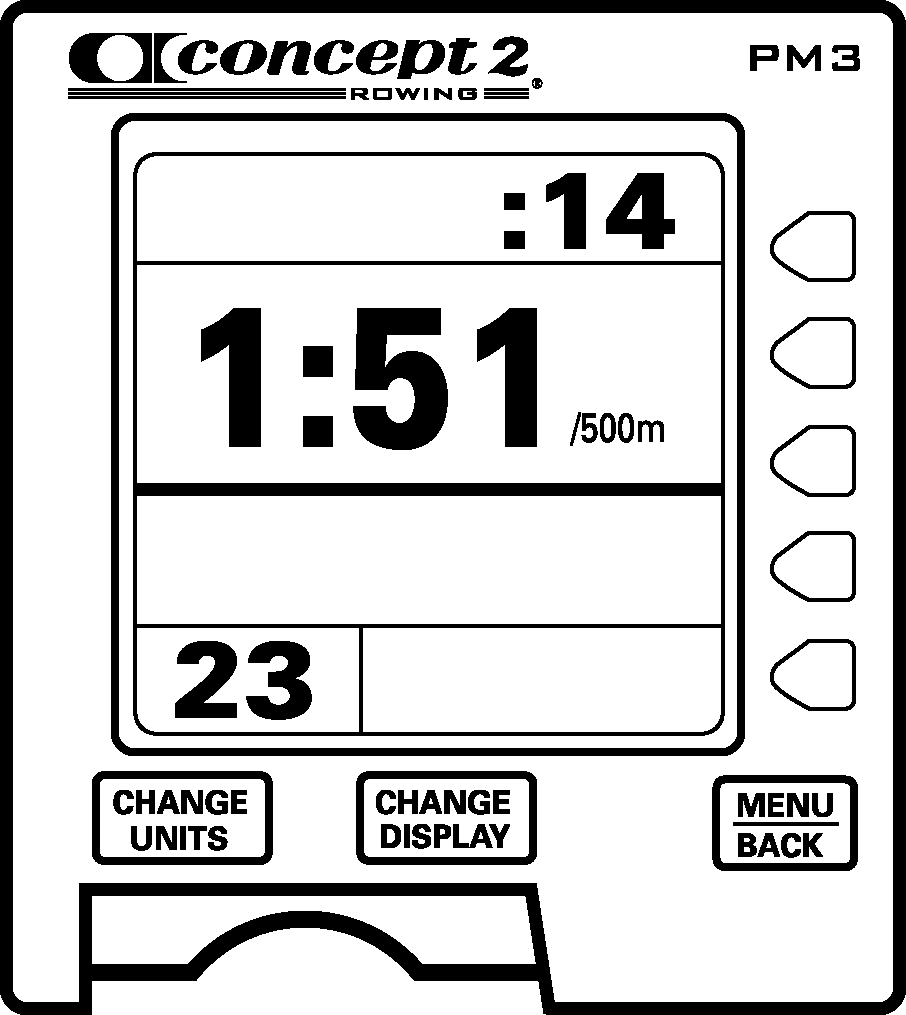
Large Print
Provides basic data in large, easy-to-read format.
Time - How long you?ve been rowing or still have to row.
Stroke Rate - Measured in strokes per minute (s/m), updated every stroke.
Stroke Output - How hard you pulled on the last stroke. Displayed in a choice of three units: pace/500m, calories/hour and watts.
Total Output - Cumulative output since you started rowing. Displayed in a choice of four units: average pace, metres, calories and average watts.
Heart Rate - If a heart rate interface is attached to the Rower and you are wearing a chestbelt transmitter, this display will show your heart rate in beats per minute.
The same basic data which appears in Large Print also appears in a smaller format in the top half of the screen of the other four displays.
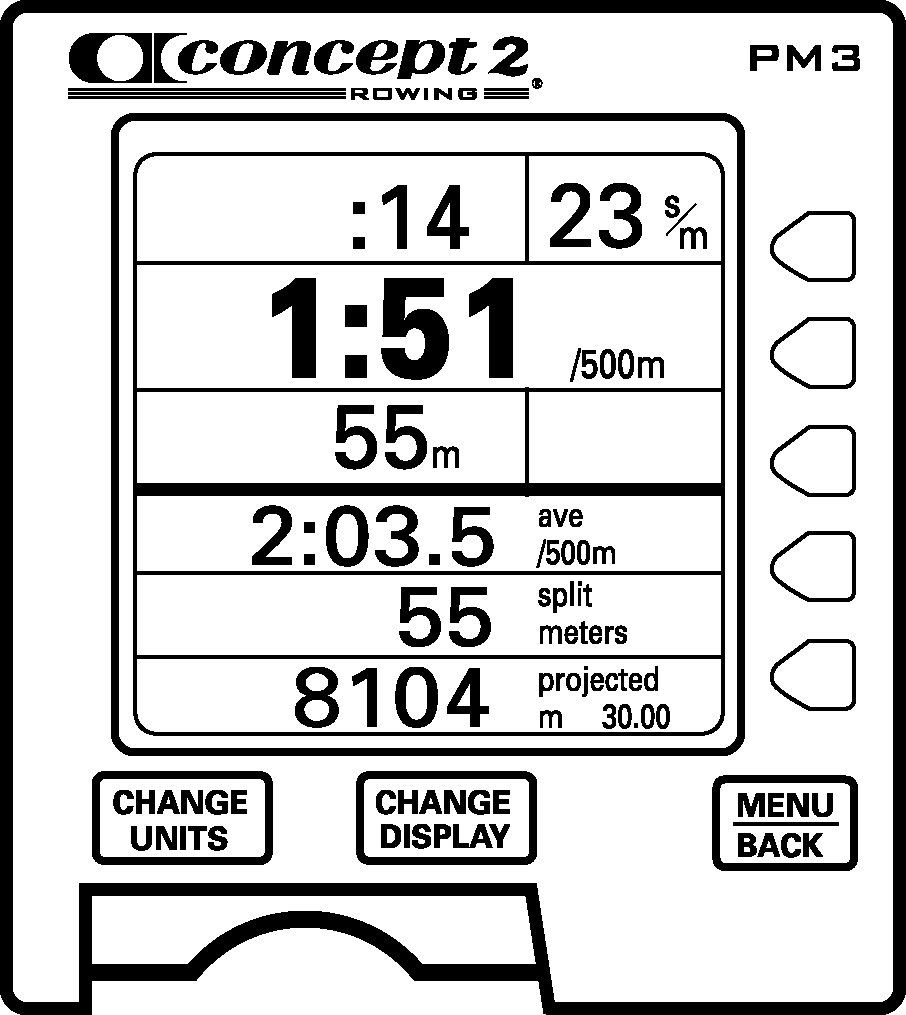
All Data
Additional numeric information is displayed.
The top line in the bottom half of the screen shows your accumulated score in time, metres or average time/500m depending on the units you have selected. During a Just Row, Single Distance or Single Time workout, the middle line shows your accumulating or average result for the current split. During a work interval the current interval number is displayed.
The bottom line is a projected score for your workout if you continue rowing at your current pace. During a Just Row workout your projected metres for a 30 minute row will be displayed. During a rest interval the total workout metres are displayed, including rest metres.
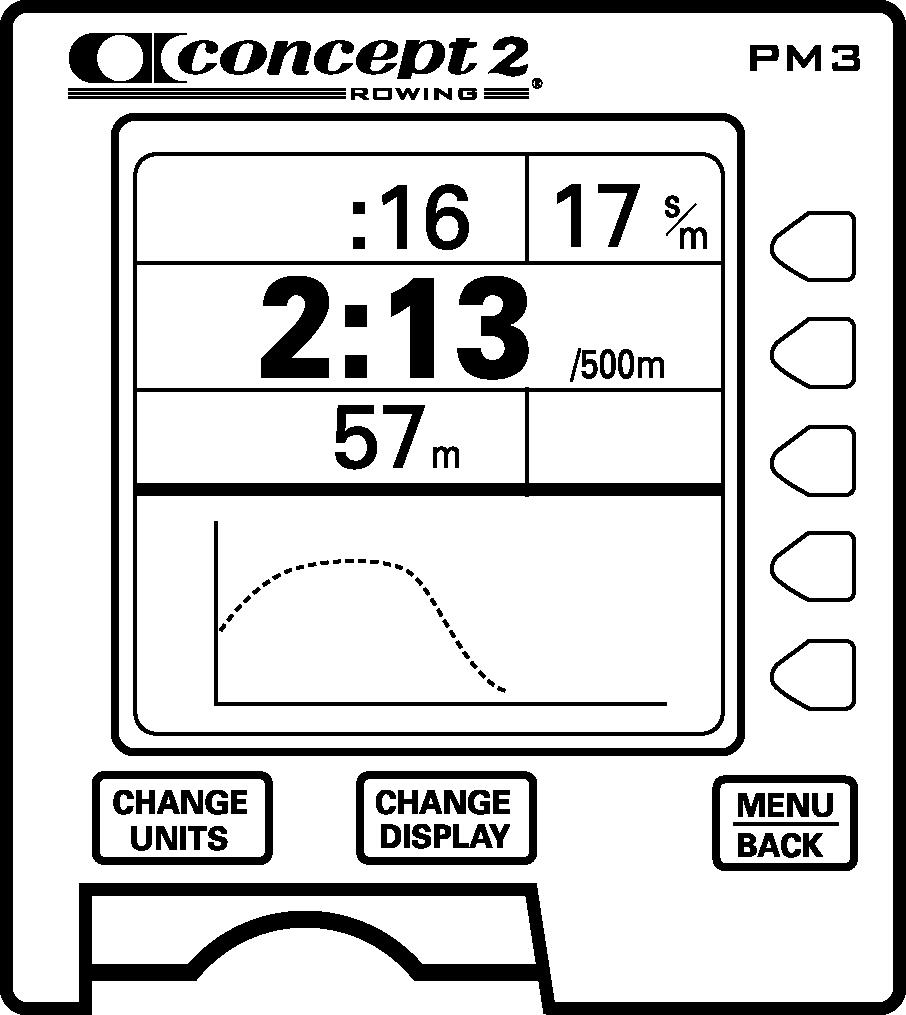
Force Curve
This is a graph of force against time which shows how you apply your force during the drive phase of each stroke.
Good technique will be illustrated by a smooth curve which builds to a peak before decaying back to zero at the finish.
Any distortion to the smooth line of the curve can be attributed to a fault in technique.
Some of the most common faults are:
- Driving the legs down too hard, causing the force time curve to rise sharply but then start to decrease before climbing again following the normal path. This type of curve is most commonly seen amongst women and can be attributed to an imbalance between a weak upper body compared to much stronger legs.
- The second most common fault is a step up or plateau just before the finish. This is more common amongst male rowers and is caused by not using the legs properly at the beginning of the drive and then tugging the finish into the body at the end of the stroke.
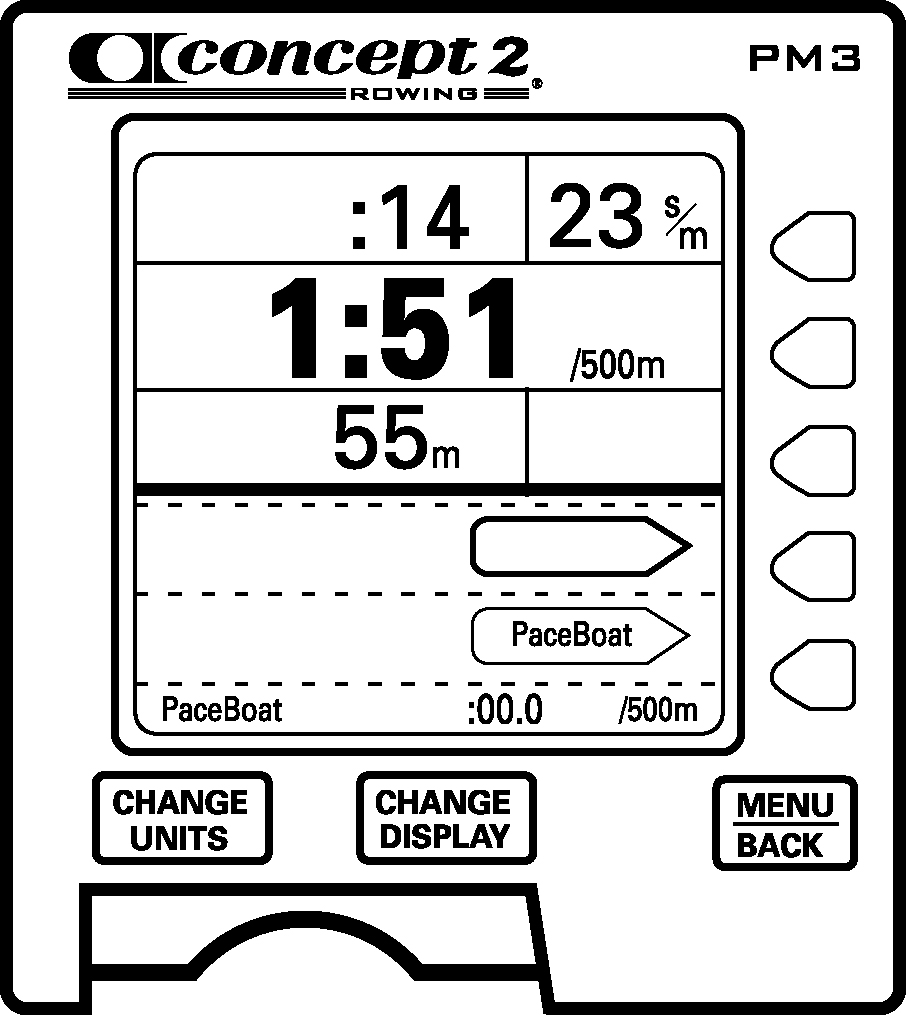
PaceBoat
Allows you to row with a virtual competitor.
To set a PaceBoat follow [Set Workout] > [New Workout]
To ReRow against a previous performance follow [Set Workout] > [ReRow]
If no pace is set the PaceBoat will simply mirror your speed. ReRow uses the selected split results for the speed of the Pace Boat.
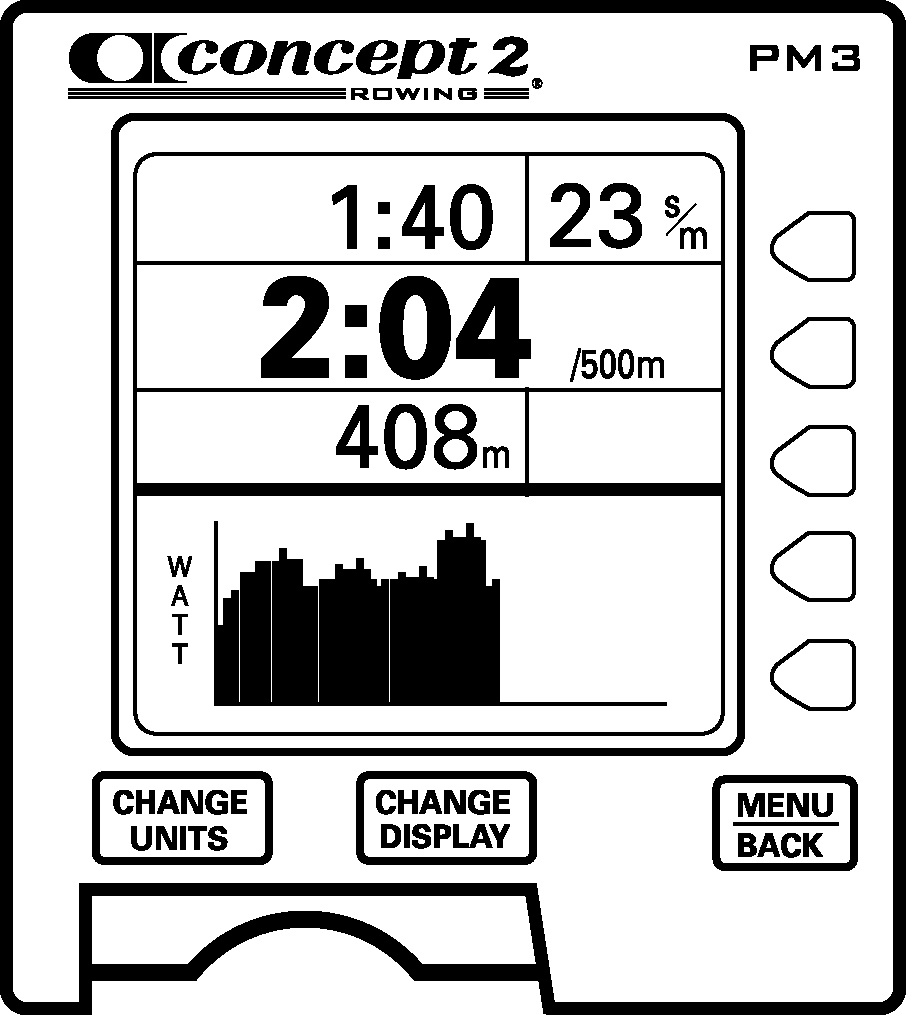
Bar Chart
Creates a graphic display of your last 50 strokes.
As you vary the intensity of your workout the range of the display will change to keep your most recent strokes in view.
If a heart rate interface is attached to the rower and you are wearing a chestbelt transmitter, your heart rate will automatically be plotted every 10 seconds instead.
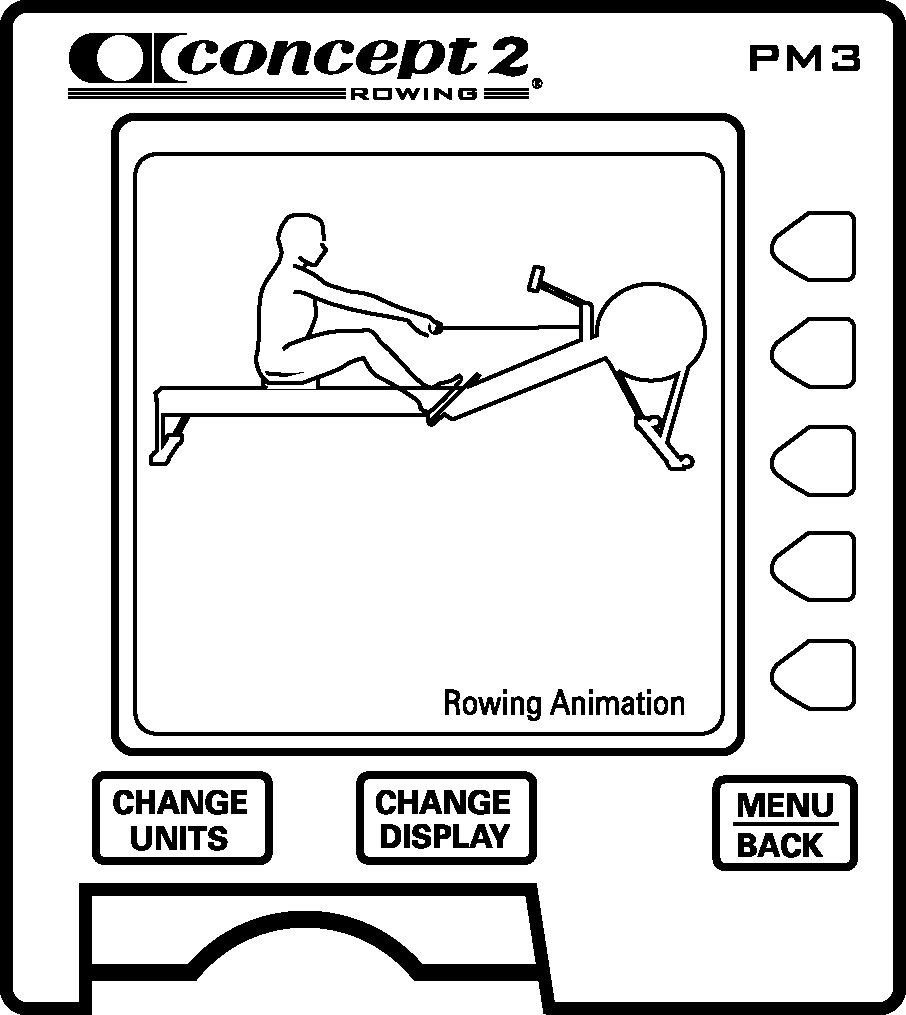
How to Row
The ?Information? section contains instruction on ?How to Row? including basic rowing technique.
Batteries and Power Generation
The PM3 uses two alkaline D-cell or IEC CR20 batteries. It also self-generates if you are using a Model D Indoor Rower or a Model C with retrofit. Depending on the speed of rowing, the PM3 will generate some or all of the power needed for its operation. This will extend the life of your batteries.
- Batteries are needed to maintain date, time, language, Custom List and Memory.
- Batteries can be removed for five minutes without loss of this information, if the PM3 is turned off before the batteries are removed.
When your batteries are low, the following warning will display when you turn on the PM3: "Replace batteries soon."
When your batteries are very low, you will be warned ?Batteries too low for normal operation?. If you keep the batteries in, and if you have the self-generation feature and start rowing fast enough, you will automatically go into Just Row mode. The display will work, but you will not be able to set up workouts, and your workout data will not be saved.
To change batteries, first allow the PM3 to power down so as not to lose any saved data. Then remove the cover, carefully pry the batteries out and replace within five minutes.
Battery Life Expectancy
- For Model B or C without retrofit: 300-400 hours.
- For Model D, or C with retrofit, normal use: almost the shelf life of the battery.
Care of PM3
Clean with damp cloth only. Do not apply liquids directly to the PM3.
NOTE:
The following formulas are used to equate the units of measure:
Watts = 2.80/(sec/meter)^3 Cal/hr = Kcal/hr = (watts) x (4) x (0.8604) + 300
Bottom View

A - Port for the optional Heart Rate Interface
B - USB port for connecting to a personal computer.
C - Flywheel sensor cable must be connected here for the PM3 to operate. The Model D/E sensor will also supply power to the PM3 while you are rowing. The PM3 can be set to operate with either the Model D/E or Model C, they are not interchangeable.

